Legal Aspects of Business: UK Business Structures Analysis
VerifiedAdded on 2021/06/17
|9
|3342
|356
Essay
AI Summary
This essay delves into the legal aspects of business in the UK, examining two prominent business structures: unlimited liability partnerships and private limited companies. It analyzes the key elements of each structure, referencing relevant legislation such as the Partnership Act 1890 and the Companies Act 2006, alongside pertinent case laws like Joyce v Morrissey and Salomon v A Salomon & Co Ltd. The essay also explores the duties of company directors as outlined in sections 171-173 of the Companies Act 2006, including acting within powers, promoting the success of the company, and considering the interests of stakeholders, with reference to cases such as Re Smith v Fawcett Ltd and Regentcrest PLC v Cohen. The analysis provides a comprehensive overview of the legal framework governing business operations and directorial responsibilities within the UK context, emphasizing the importance of compliance and ethical conduct.
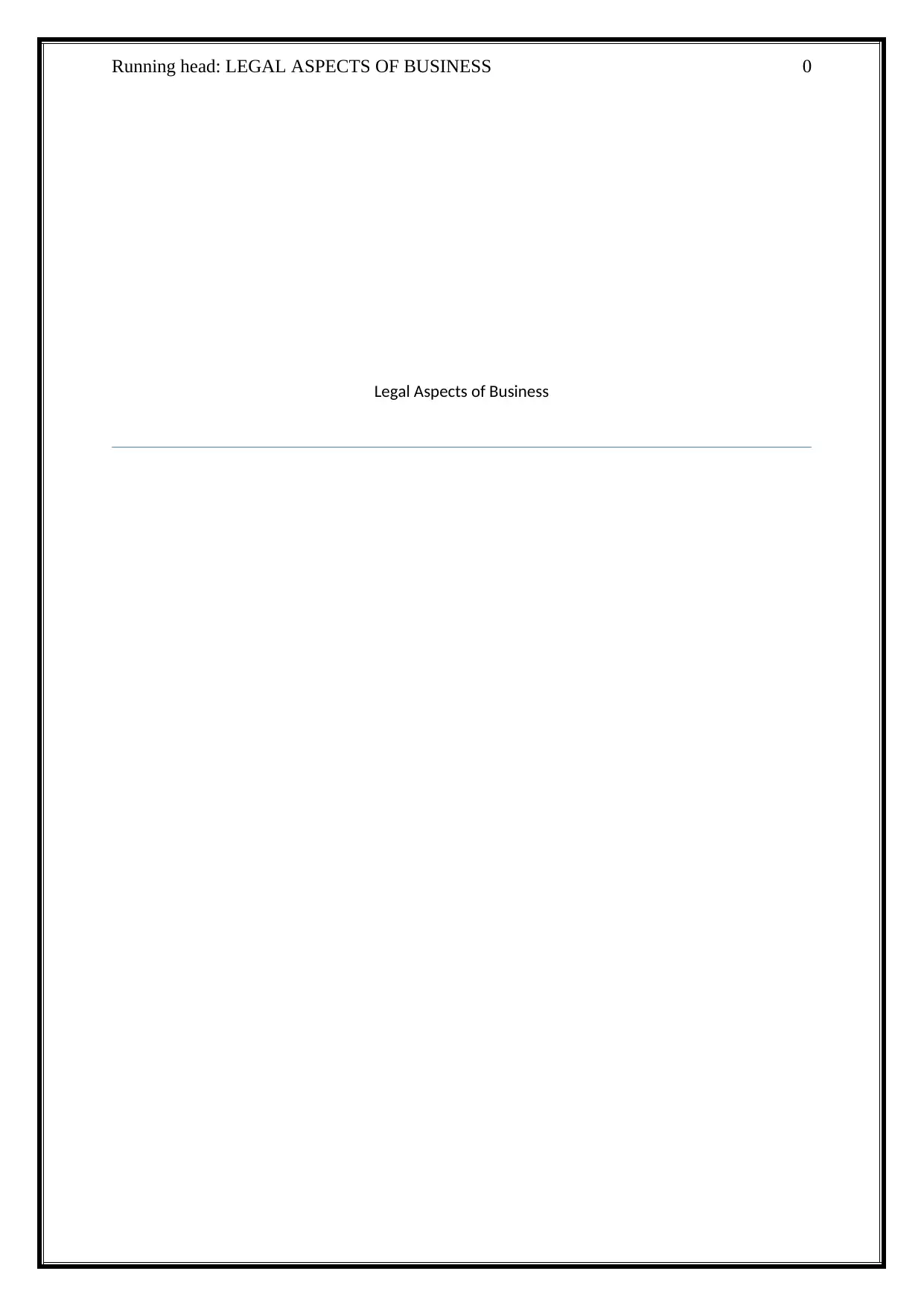
Running head: LEGAL ASPECTS OF BUSINESS 0
Legal Aspects of Business
Legal Aspects of Business
Paraphrase This Document
Need a fresh take? Get an instant paraphrase of this document with our AI Paraphraser
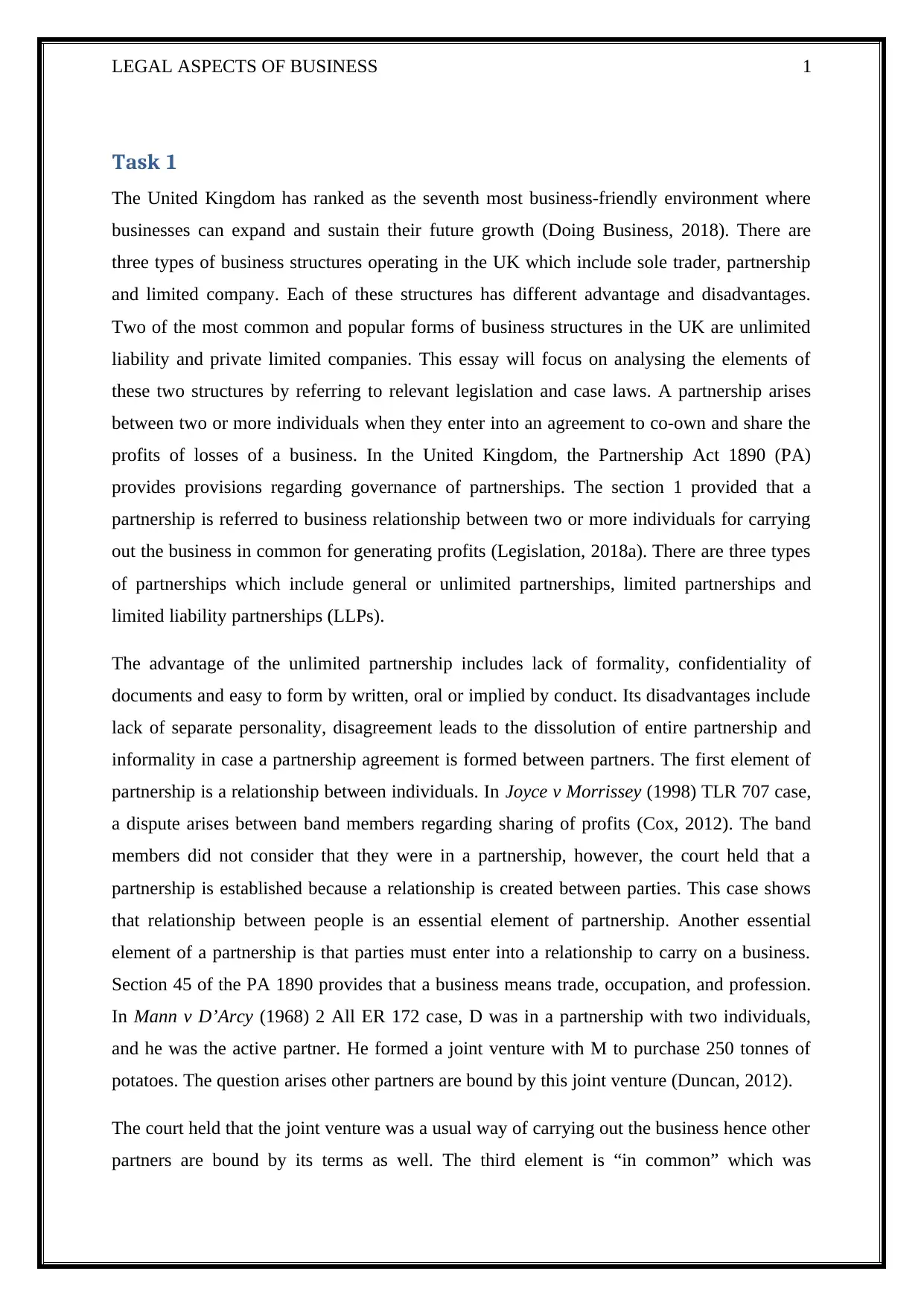
LEGAL ASPECTS OF BUSINESS 1
Task 1
The United Kingdom has ranked as the seventh most business-friendly environment where
businesses can expand and sustain their future growth (Doing Business, 2018). There are
three types of business structures operating in the UK which include sole trader, partnership
and limited company. Each of these structures has different advantage and disadvantages.
Two of the most common and popular forms of business structures in the UK are unlimited
liability and private limited companies. This essay will focus on analysing the elements of
these two structures by referring to relevant legislation and case laws. A partnership arises
between two or more individuals when they enter into an agreement to co-own and share the
profits of losses of a business. In the United Kingdom, the Partnership Act 1890 (PA)
provides provisions regarding governance of partnerships. The section 1 provided that a
partnership is referred to business relationship between two or more individuals for carrying
out the business in common for generating profits (Legislation, 2018a). There are three types
of partnerships which include general or unlimited partnerships, limited partnerships and
limited liability partnerships (LLPs).
The advantage of the unlimited partnership includes lack of formality, confidentiality of
documents and easy to form by written, oral or implied by conduct. Its disadvantages include
lack of separate personality, disagreement leads to the dissolution of entire partnership and
informality in case a partnership agreement is formed between partners. The first element of
partnership is a relationship between individuals. In Joyce v Morrissey (1998) TLR 707 case,
a dispute arises between band members regarding sharing of profits (Cox, 2012). The band
members did not consider that they were in a partnership, however, the court held that a
partnership is established because a relationship is created between parties. This case shows
that relationship between people is an essential element of partnership. Another essential
element of a partnership is that parties must enter into a relationship to carry on a business.
Section 45 of the PA 1890 provides that a business means trade, occupation, and profession.
In Mann v D’Arcy (1968) 2 All ER 172 case, D was in a partnership with two individuals,
and he was the active partner. He formed a joint venture with M to purchase 250 tonnes of
potatoes. The question arises other partners are bound by this joint venture (Duncan, 2012).
The court held that the joint venture was a usual way of carrying out the business hence other
partners are bound by its terms as well. The third element is “in common” which was
Task 1
The United Kingdom has ranked as the seventh most business-friendly environment where
businesses can expand and sustain their future growth (Doing Business, 2018). There are
three types of business structures operating in the UK which include sole trader, partnership
and limited company. Each of these structures has different advantage and disadvantages.
Two of the most common and popular forms of business structures in the UK are unlimited
liability and private limited companies. This essay will focus on analysing the elements of
these two structures by referring to relevant legislation and case laws. A partnership arises
between two or more individuals when they enter into an agreement to co-own and share the
profits of losses of a business. In the United Kingdom, the Partnership Act 1890 (PA)
provides provisions regarding governance of partnerships. The section 1 provided that a
partnership is referred to business relationship between two or more individuals for carrying
out the business in common for generating profits (Legislation, 2018a). There are three types
of partnerships which include general or unlimited partnerships, limited partnerships and
limited liability partnerships (LLPs).
The advantage of the unlimited partnership includes lack of formality, confidentiality of
documents and easy to form by written, oral or implied by conduct. Its disadvantages include
lack of separate personality, disagreement leads to the dissolution of entire partnership and
informality in case a partnership agreement is formed between partners. The first element of
partnership is a relationship between individuals. In Joyce v Morrissey (1998) TLR 707 case,
a dispute arises between band members regarding sharing of profits (Cox, 2012). The band
members did not consider that they were in a partnership, however, the court held that a
partnership is established because a relationship is created between parties. This case shows
that relationship between people is an essential element of partnership. Another essential
element of a partnership is that parties must enter into a relationship to carry on a business.
Section 45 of the PA 1890 provides that a business means trade, occupation, and profession.
In Mann v D’Arcy (1968) 2 All ER 172 case, D was in a partnership with two individuals,
and he was the active partner. He formed a joint venture with M to purchase 250 tonnes of
potatoes. The question arises other partners are bound by this joint venture (Duncan, 2012).
The court held that the joint venture was a usual way of carrying out the business hence other
partners are bound by its terms as well. The third element is “in common” which was
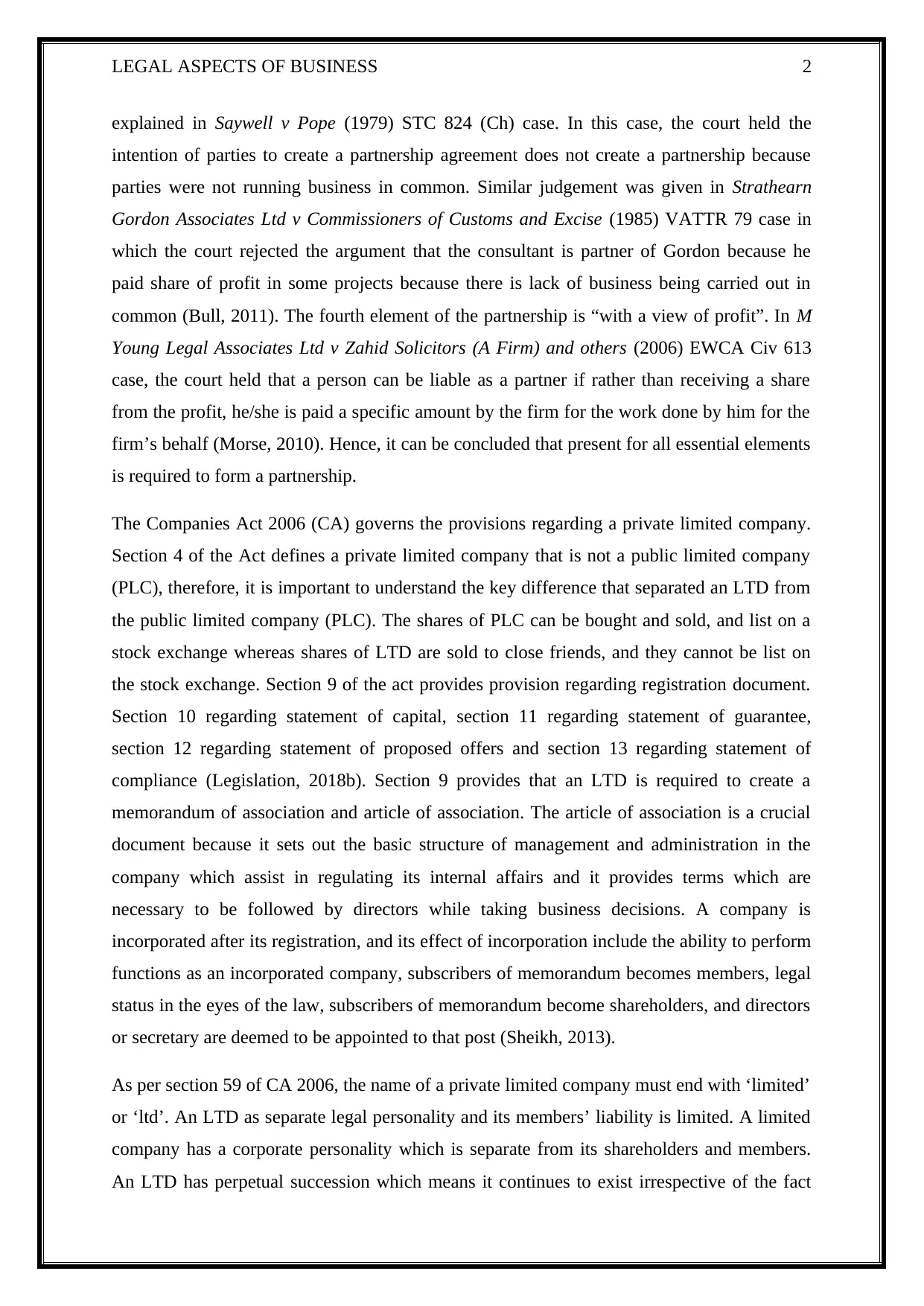
LEGAL ASPECTS OF BUSINESS 2
explained in Saywell v Pope (1979) STC 824 (Ch) case. In this case, the court held the
intention of parties to create a partnership agreement does not create a partnership because
parties were not running business in common. Similar judgement was given in Strathearn
Gordon Associates Ltd v Commissioners of Customs and Excise (1985) VATTR 79 case in
which the court rejected the argument that the consultant is partner of Gordon because he
paid share of profit in some projects because there is lack of business being carried out in
common (Bull, 2011). The fourth element of the partnership is “with a view of profit”. In M
Young Legal Associates Ltd v Zahid Solicitors (A Firm) and others (2006) EWCA Civ 613
case, the court held that a person can be liable as a partner if rather than receiving a share
from the profit, he/she is paid a specific amount by the firm for the work done by him for the
firm’s behalf (Morse, 2010). Hence, it can be concluded that present for all essential elements
is required to form a partnership.
The Companies Act 2006 (CA) governs the provisions regarding a private limited company.
Section 4 of the Act defines a private limited company that is not a public limited company
(PLC), therefore, it is important to understand the key difference that separated an LTD from
the public limited company (PLC). The shares of PLC can be bought and sold, and list on a
stock exchange whereas shares of LTD are sold to close friends, and they cannot be list on
the stock exchange. Section 9 of the act provides provision regarding registration document.
Section 10 regarding statement of capital, section 11 regarding statement of guarantee,
section 12 regarding statement of proposed offers and section 13 regarding statement of
compliance (Legislation, 2018b). Section 9 provides that an LTD is required to create a
memorandum of association and article of association. The article of association is a crucial
document because it sets out the basic structure of management and administration in the
company which assist in regulating its internal affairs and it provides terms which are
necessary to be followed by directors while taking business decisions. A company is
incorporated after its registration, and its effect of incorporation include the ability to perform
functions as an incorporated company, subscribers of memorandum becomes members, legal
status in the eyes of the law, subscribers of memorandum become shareholders, and directors
or secretary are deemed to be appointed to that post (Sheikh, 2013).
As per section 59 of CA 2006, the name of a private limited company must end with ‘limited’
or ‘ltd’. An LTD as separate legal personality and its members’ liability is limited. A limited
company has a corporate personality which is separate from its shareholders and members.
An LTD has perpetual succession which means it continues to exist irrespective of the fact
explained in Saywell v Pope (1979) STC 824 (Ch) case. In this case, the court held the
intention of parties to create a partnership agreement does not create a partnership because
parties were not running business in common. Similar judgement was given in Strathearn
Gordon Associates Ltd v Commissioners of Customs and Excise (1985) VATTR 79 case in
which the court rejected the argument that the consultant is partner of Gordon because he
paid share of profit in some projects because there is lack of business being carried out in
common (Bull, 2011). The fourth element of the partnership is “with a view of profit”. In M
Young Legal Associates Ltd v Zahid Solicitors (A Firm) and others (2006) EWCA Civ 613
case, the court held that a person can be liable as a partner if rather than receiving a share
from the profit, he/she is paid a specific amount by the firm for the work done by him for the
firm’s behalf (Morse, 2010). Hence, it can be concluded that present for all essential elements
is required to form a partnership.
The Companies Act 2006 (CA) governs the provisions regarding a private limited company.
Section 4 of the Act defines a private limited company that is not a public limited company
(PLC), therefore, it is important to understand the key difference that separated an LTD from
the public limited company (PLC). The shares of PLC can be bought and sold, and list on a
stock exchange whereas shares of LTD are sold to close friends, and they cannot be list on
the stock exchange. Section 9 of the act provides provision regarding registration document.
Section 10 regarding statement of capital, section 11 regarding statement of guarantee,
section 12 regarding statement of proposed offers and section 13 regarding statement of
compliance (Legislation, 2018b). Section 9 provides that an LTD is required to create a
memorandum of association and article of association. The article of association is a crucial
document because it sets out the basic structure of management and administration in the
company which assist in regulating its internal affairs and it provides terms which are
necessary to be followed by directors while taking business decisions. A company is
incorporated after its registration, and its effect of incorporation include the ability to perform
functions as an incorporated company, subscribers of memorandum becomes members, legal
status in the eyes of the law, subscribers of memorandum become shareholders, and directors
or secretary are deemed to be appointed to that post (Sheikh, 2013).
As per section 59 of CA 2006, the name of a private limited company must end with ‘limited’
or ‘ltd’. An LTD as separate legal personality and its members’ liability is limited. A limited
company has a corporate personality which is separate from its shareholders and members.
An LTD has perpetual succession which means it continues to exist irrespective of the fact
⊘ This is a preview!⊘
Do you want full access?
Subscribe today to unlock all pages.

Trusted by 1+ million students worldwide
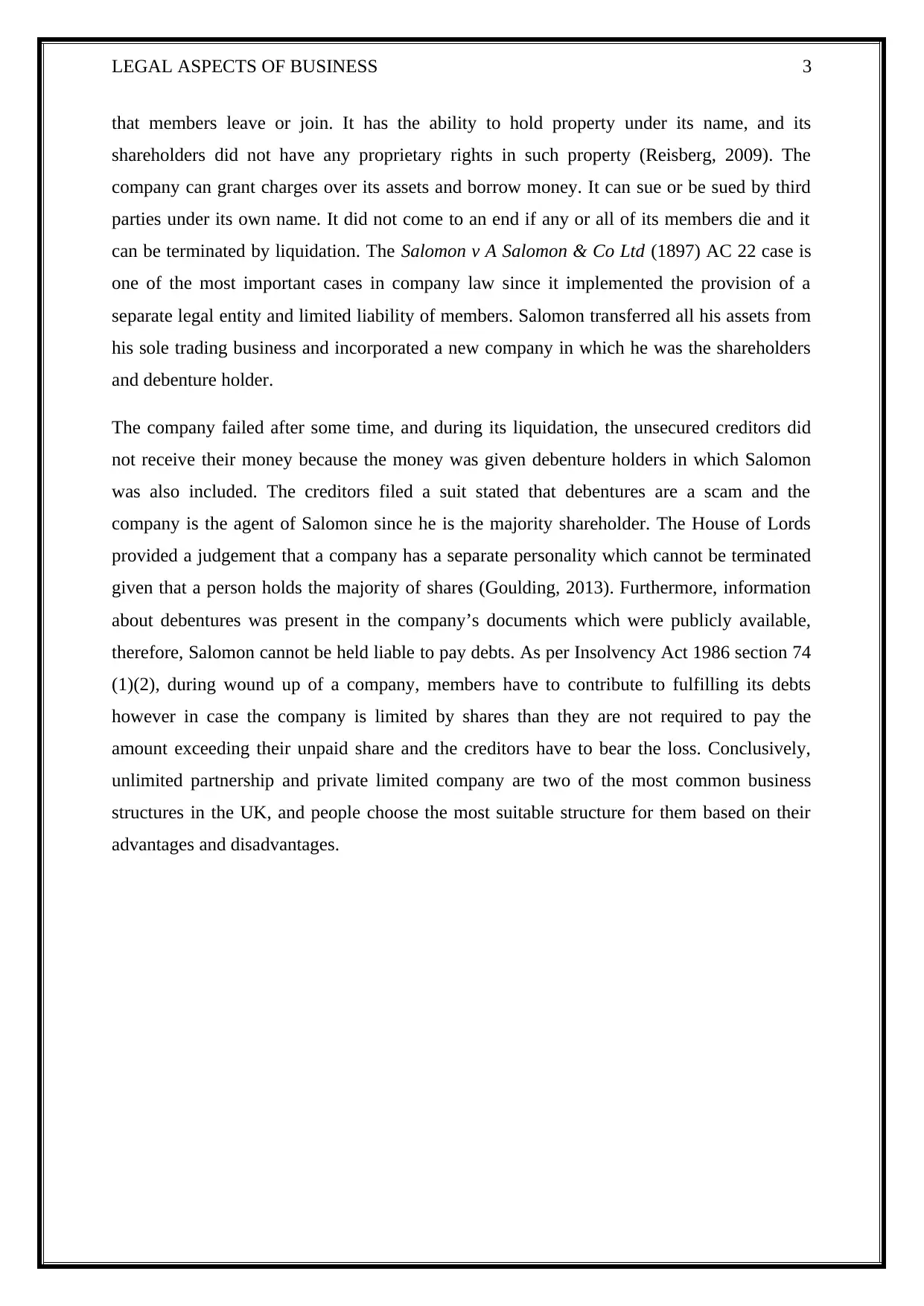
LEGAL ASPECTS OF BUSINESS 3
that members leave or join. It has the ability to hold property under its name, and its
shareholders did not have any proprietary rights in such property (Reisberg, 2009). The
company can grant charges over its assets and borrow money. It can sue or be sued by third
parties under its own name. It did not come to an end if any or all of its members die and it
can be terminated by liquidation. The Salomon v A Salomon & Co Ltd (1897) AC 22 case is
one of the most important cases in company law since it implemented the provision of a
separate legal entity and limited liability of members. Salomon transferred all his assets from
his sole trading business and incorporated a new company in which he was the shareholders
and debenture holder.
The company failed after some time, and during its liquidation, the unsecured creditors did
not receive their money because the money was given debenture holders in which Salomon
was also included. The creditors filed a suit stated that debentures are a scam and the
company is the agent of Salomon since he is the majority shareholder. The House of Lords
provided a judgement that a company has a separate personality which cannot be terminated
given that a person holds the majority of shares (Goulding, 2013). Furthermore, information
about debentures was present in the company’s documents which were publicly available,
therefore, Salomon cannot be held liable to pay debts. As per Insolvency Act 1986 section 74
(1)(2), during wound up of a company, members have to contribute to fulfilling its debts
however in case the company is limited by shares than they are not required to pay the
amount exceeding their unpaid share and the creditors have to bear the loss. Conclusively,
unlimited partnership and private limited company are two of the most common business
structures in the UK, and people choose the most suitable structure for them based on their
advantages and disadvantages.
that members leave or join. It has the ability to hold property under its name, and its
shareholders did not have any proprietary rights in such property (Reisberg, 2009). The
company can grant charges over its assets and borrow money. It can sue or be sued by third
parties under its own name. It did not come to an end if any or all of its members die and it
can be terminated by liquidation. The Salomon v A Salomon & Co Ltd (1897) AC 22 case is
one of the most important cases in company law since it implemented the provision of a
separate legal entity and limited liability of members. Salomon transferred all his assets from
his sole trading business and incorporated a new company in which he was the shareholders
and debenture holder.
The company failed after some time, and during its liquidation, the unsecured creditors did
not receive their money because the money was given debenture holders in which Salomon
was also included. The creditors filed a suit stated that debentures are a scam and the
company is the agent of Salomon since he is the majority shareholder. The House of Lords
provided a judgement that a company has a separate personality which cannot be terminated
given that a person holds the majority of shares (Goulding, 2013). Furthermore, information
about debentures was present in the company’s documents which were publicly available,
therefore, Salomon cannot be held liable to pay debts. As per Insolvency Act 1986 section 74
(1)(2), during wound up of a company, members have to contribute to fulfilling its debts
however in case the company is limited by shares than they are not required to pay the
amount exceeding their unpaid share and the creditors have to bear the loss. Conclusively,
unlimited partnership and private limited company are two of the most common business
structures in the UK, and people choose the most suitable structure for them based on their
advantages and disadvantages.
Paraphrase This Document
Need a fresh take? Get an instant paraphrase of this document with our AI Paraphraser
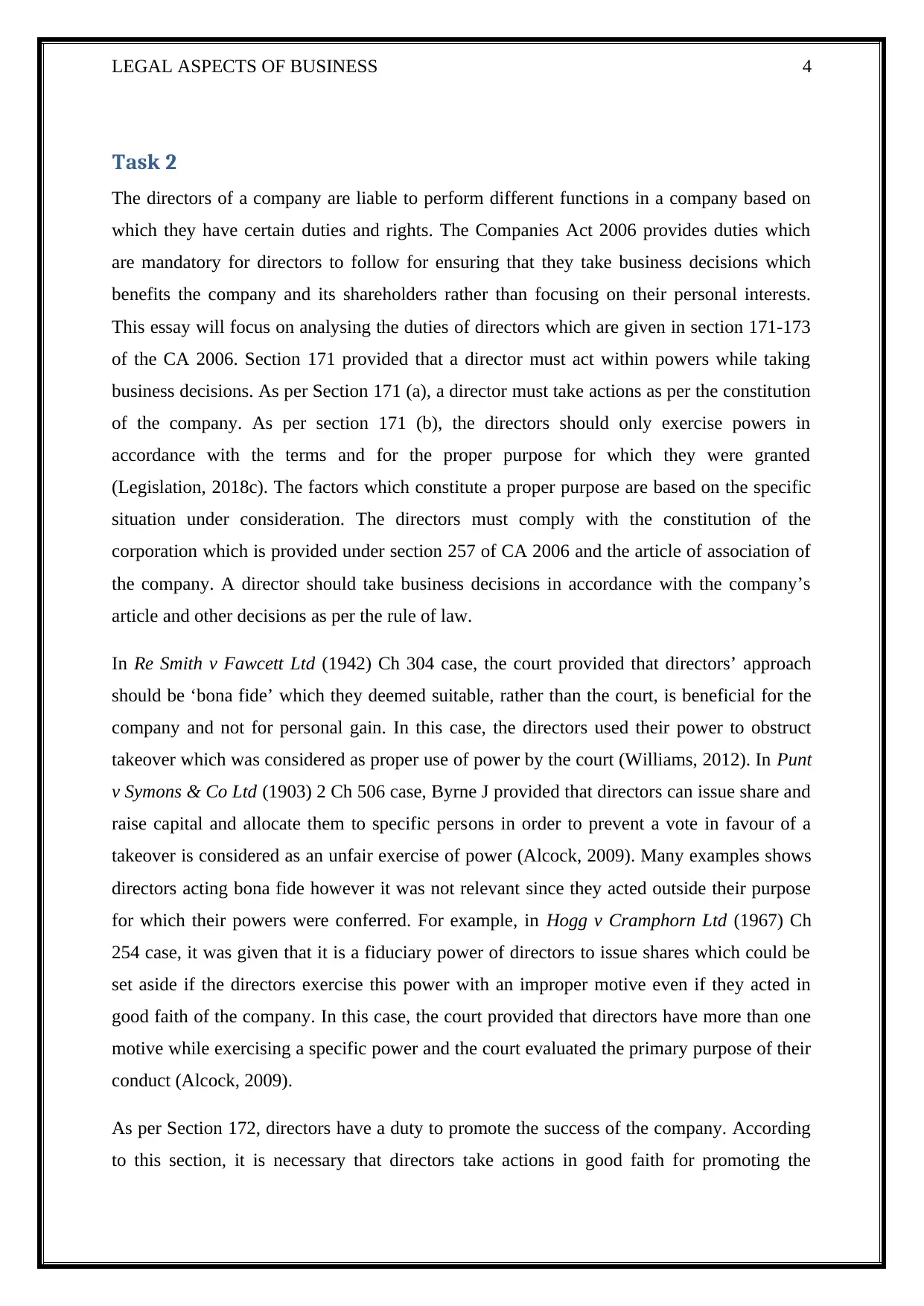
LEGAL ASPECTS OF BUSINESS 4
Task 2
The directors of a company are liable to perform different functions in a company based on
which they have certain duties and rights. The Companies Act 2006 provides duties which
are mandatory for directors to follow for ensuring that they take business decisions which
benefits the company and its shareholders rather than focusing on their personal interests.
This essay will focus on analysing the duties of directors which are given in section 171-173
of the CA 2006. Section 171 provided that a director must act within powers while taking
business decisions. As per Section 171 (a), a director must take actions as per the constitution
of the company. As per section 171 (b), the directors should only exercise powers in
accordance with the terms and for the proper purpose for which they were granted
(Legislation, 2018c). The factors which constitute a proper purpose are based on the specific
situation under consideration. The directors must comply with the constitution of the
corporation which is provided under section 257 of CA 2006 and the article of association of
the company. A director should take business decisions in accordance with the company’s
article and other decisions as per the rule of law.
In Re Smith v Fawcett Ltd (1942) Ch 304 case, the court provided that directors’ approach
should be ‘bona fide’ which they deemed suitable, rather than the court, is beneficial for the
company and not for personal gain. In this case, the directors used their power to obstruct
takeover which was considered as proper use of power by the court (Williams, 2012). In Punt
v Symons & Co Ltd (1903) 2 Ch 506 case, Byrne J provided that directors can issue share and
raise capital and allocate them to specific persons in order to prevent a vote in favour of a
takeover is considered as an unfair exercise of power (Alcock, 2009). Many examples shows
directors acting bona fide however it was not relevant since they acted outside their purpose
for which their powers were conferred. For example, in Hogg v Cramphorn Ltd (1967) Ch
254 case, it was given that it is a fiduciary power of directors to issue shares which could be
set aside if the directors exercise this power with an improper motive even if they acted in
good faith of the company. In this case, the court provided that directors have more than one
motive while exercising a specific power and the court evaluated the primary purpose of their
conduct (Alcock, 2009).
As per Section 172, directors have a duty to promote the success of the company. According
to this section, it is necessary that directors take actions in good faith for promoting the
Task 2
The directors of a company are liable to perform different functions in a company based on
which they have certain duties and rights. The Companies Act 2006 provides duties which
are mandatory for directors to follow for ensuring that they take business decisions which
benefits the company and its shareholders rather than focusing on their personal interests.
This essay will focus on analysing the duties of directors which are given in section 171-173
of the CA 2006. Section 171 provided that a director must act within powers while taking
business decisions. As per Section 171 (a), a director must take actions as per the constitution
of the company. As per section 171 (b), the directors should only exercise powers in
accordance with the terms and for the proper purpose for which they were granted
(Legislation, 2018c). The factors which constitute a proper purpose are based on the specific
situation under consideration. The directors must comply with the constitution of the
corporation which is provided under section 257 of CA 2006 and the article of association of
the company. A director should take business decisions in accordance with the company’s
article and other decisions as per the rule of law.
In Re Smith v Fawcett Ltd (1942) Ch 304 case, the court provided that directors’ approach
should be ‘bona fide’ which they deemed suitable, rather than the court, is beneficial for the
company and not for personal gain. In this case, the directors used their power to obstruct
takeover which was considered as proper use of power by the court (Williams, 2012). In Punt
v Symons & Co Ltd (1903) 2 Ch 506 case, Byrne J provided that directors can issue share and
raise capital and allocate them to specific persons in order to prevent a vote in favour of a
takeover is considered as an unfair exercise of power (Alcock, 2009). Many examples shows
directors acting bona fide however it was not relevant since they acted outside their purpose
for which their powers were conferred. For example, in Hogg v Cramphorn Ltd (1967) Ch
254 case, it was given that it is a fiduciary power of directors to issue shares which could be
set aside if the directors exercise this power with an improper motive even if they acted in
good faith of the company. In this case, the court provided that directors have more than one
motive while exercising a specific power and the court evaluated the primary purpose of their
conduct (Alcock, 2009).
As per Section 172, directors have a duty to promote the success of the company. According
to this section, it is necessary that directors take actions in good faith for promoting the
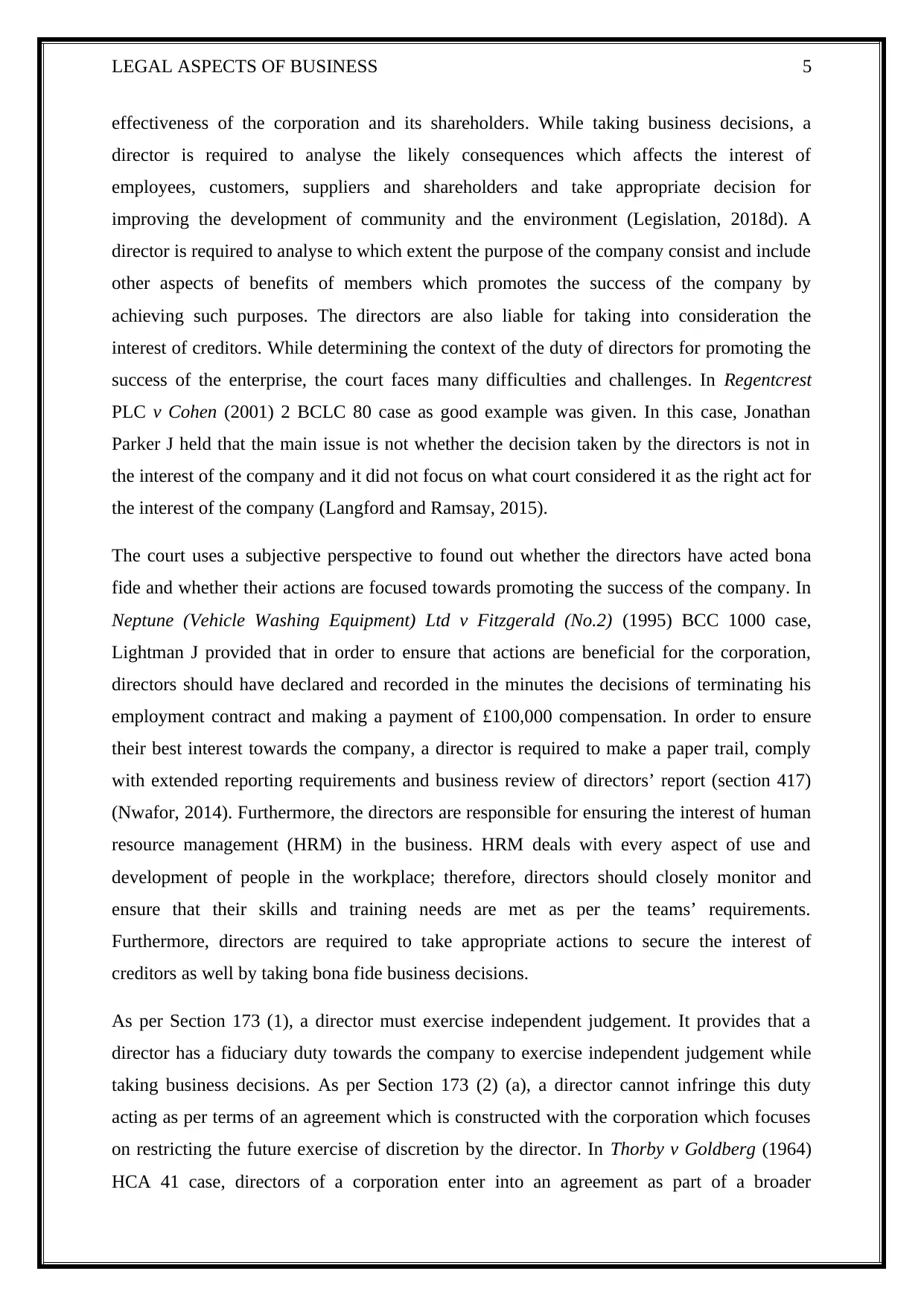
LEGAL ASPECTS OF BUSINESS 5
effectiveness of the corporation and its shareholders. While taking business decisions, a
director is required to analyse the likely consequences which affects the interest of
employees, customers, suppliers and shareholders and take appropriate decision for
improving the development of community and the environment (Legislation, 2018d). A
director is required to analyse to which extent the purpose of the company consist and include
other aspects of benefits of members which promotes the success of the company by
achieving such purposes. The directors are also liable for taking into consideration the
interest of creditors. While determining the context of the duty of directors for promoting the
success of the enterprise, the court faces many difficulties and challenges. In Regentcrest
PLC v Cohen (2001) 2 BCLC 80 case as good example was given. In this case, Jonathan
Parker J held that the main issue is not whether the decision taken by the directors is not in
the interest of the company and it did not focus on what court considered it as the right act for
the interest of the company (Langford and Ramsay, 2015).
The court uses a subjective perspective to found out whether the directors have acted bona
fide and whether their actions are focused towards promoting the success of the company. In
Neptune (Vehicle Washing Equipment) Ltd v Fitzgerald (No.2) (1995) BCC 1000 case,
Lightman J provided that in order to ensure that actions are beneficial for the corporation,
directors should have declared and recorded in the minutes the decisions of terminating his
employment contract and making a payment of £100,000 compensation. In order to ensure
their best interest towards the company, a director is required to make a paper trail, comply
with extended reporting requirements and business review of directors’ report (section 417)
(Nwafor, 2014). Furthermore, the directors are responsible for ensuring the interest of human
resource management (HRM) in the business. HRM deals with every aspect of use and
development of people in the workplace; therefore, directors should closely monitor and
ensure that their skills and training needs are met as per the teams’ requirements.
Furthermore, directors are required to take appropriate actions to secure the interest of
creditors as well by taking bona fide business decisions.
As per Section 173 (1), a director must exercise independent judgement. It provides that a
director has a fiduciary duty towards the company to exercise independent judgement while
taking business decisions. As per Section 173 (2) (a), a director cannot infringe this duty
acting as per terms of an agreement which is constructed with the corporation which focuses
on restricting the future exercise of discretion by the director. In Thorby v Goldberg (1964)
HCA 41 case, directors of a corporation enter into an agreement as part of a broader
effectiveness of the corporation and its shareholders. While taking business decisions, a
director is required to analyse the likely consequences which affects the interest of
employees, customers, suppliers and shareholders and take appropriate decision for
improving the development of community and the environment (Legislation, 2018d). A
director is required to analyse to which extent the purpose of the company consist and include
other aspects of benefits of members which promotes the success of the company by
achieving such purposes. The directors are also liable for taking into consideration the
interest of creditors. While determining the context of the duty of directors for promoting the
success of the enterprise, the court faces many difficulties and challenges. In Regentcrest
PLC v Cohen (2001) 2 BCLC 80 case as good example was given. In this case, Jonathan
Parker J held that the main issue is not whether the decision taken by the directors is not in
the interest of the company and it did not focus on what court considered it as the right act for
the interest of the company (Langford and Ramsay, 2015).
The court uses a subjective perspective to found out whether the directors have acted bona
fide and whether their actions are focused towards promoting the success of the company. In
Neptune (Vehicle Washing Equipment) Ltd v Fitzgerald (No.2) (1995) BCC 1000 case,
Lightman J provided that in order to ensure that actions are beneficial for the corporation,
directors should have declared and recorded in the minutes the decisions of terminating his
employment contract and making a payment of £100,000 compensation. In order to ensure
their best interest towards the company, a director is required to make a paper trail, comply
with extended reporting requirements and business review of directors’ report (section 417)
(Nwafor, 2014). Furthermore, the directors are responsible for ensuring the interest of human
resource management (HRM) in the business. HRM deals with every aspect of use and
development of people in the workplace; therefore, directors should closely monitor and
ensure that their skills and training needs are met as per the teams’ requirements.
Furthermore, directors are required to take appropriate actions to secure the interest of
creditors as well by taking bona fide business decisions.
As per Section 173 (1), a director must exercise independent judgement. It provides that a
director has a fiduciary duty towards the company to exercise independent judgement while
taking business decisions. As per Section 173 (2) (a), a director cannot infringe this duty
acting as per terms of an agreement which is constructed with the corporation which focuses
on restricting the future exercise of discretion by the director. In Thorby v Goldberg (1964)
HCA 41 case, directors of a corporation enter into an agreement as part of a broader
⊘ This is a preview!⊘
Do you want full access?
Subscribe today to unlock all pages.

Trusted by 1+ million students worldwide
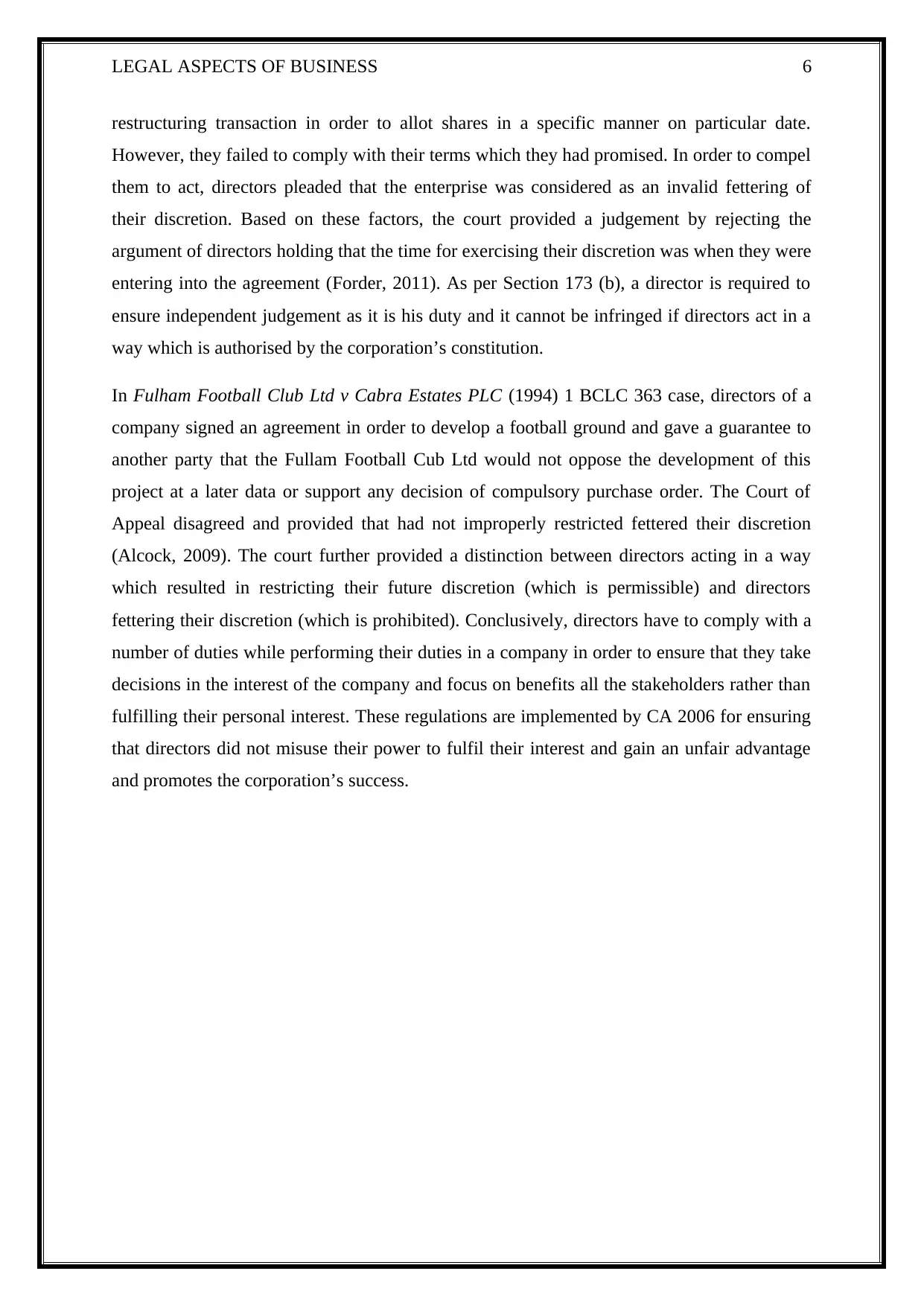
LEGAL ASPECTS OF BUSINESS 6
restructuring transaction in order to allot shares in a specific manner on particular date.
However, they failed to comply with their terms which they had promised. In order to compel
them to act, directors pleaded that the enterprise was considered as an invalid fettering of
their discretion. Based on these factors, the court provided a judgement by rejecting the
argument of directors holding that the time for exercising their discretion was when they were
entering into the agreement (Forder, 2011). As per Section 173 (b), a director is required to
ensure independent judgement as it is his duty and it cannot be infringed if directors act in a
way which is authorised by the corporation’s constitution.
In Fulham Football Club Ltd v Cabra Estates PLC (1994) 1 BCLC 363 case, directors of a
company signed an agreement in order to develop a football ground and gave a guarantee to
another party that the Fullam Football Cub Ltd would not oppose the development of this
project at a later data or support any decision of compulsory purchase order. The Court of
Appeal disagreed and provided that had not improperly restricted fettered their discretion
(Alcock, 2009). The court further provided a distinction between directors acting in a way
which resulted in restricting their future discretion (which is permissible) and directors
fettering their discretion (which is prohibited). Conclusively, directors have to comply with a
number of duties while performing their duties in a company in order to ensure that they take
decisions in the interest of the company and focus on benefits all the stakeholders rather than
fulfilling their personal interest. These regulations are implemented by CA 2006 for ensuring
that directors did not misuse their power to fulfil their interest and gain an unfair advantage
and promotes the corporation’s success.
restructuring transaction in order to allot shares in a specific manner on particular date.
However, they failed to comply with their terms which they had promised. In order to compel
them to act, directors pleaded that the enterprise was considered as an invalid fettering of
their discretion. Based on these factors, the court provided a judgement by rejecting the
argument of directors holding that the time for exercising their discretion was when they were
entering into the agreement (Forder, 2011). As per Section 173 (b), a director is required to
ensure independent judgement as it is his duty and it cannot be infringed if directors act in a
way which is authorised by the corporation’s constitution.
In Fulham Football Club Ltd v Cabra Estates PLC (1994) 1 BCLC 363 case, directors of a
company signed an agreement in order to develop a football ground and gave a guarantee to
another party that the Fullam Football Cub Ltd would not oppose the development of this
project at a later data or support any decision of compulsory purchase order. The Court of
Appeal disagreed and provided that had not improperly restricted fettered their discretion
(Alcock, 2009). The court further provided a distinction between directors acting in a way
which resulted in restricting their future discretion (which is permissible) and directors
fettering their discretion (which is prohibited). Conclusively, directors have to comply with a
number of duties while performing their duties in a company in order to ensure that they take
decisions in the interest of the company and focus on benefits all the stakeholders rather than
fulfilling their personal interest. These regulations are implemented by CA 2006 for ensuring
that directors did not misuse their power to fulfil their interest and gain an unfair advantage
and promotes the corporation’s success.
Paraphrase This Document
Need a fresh take? Get an instant paraphrase of this document with our AI Paraphraser
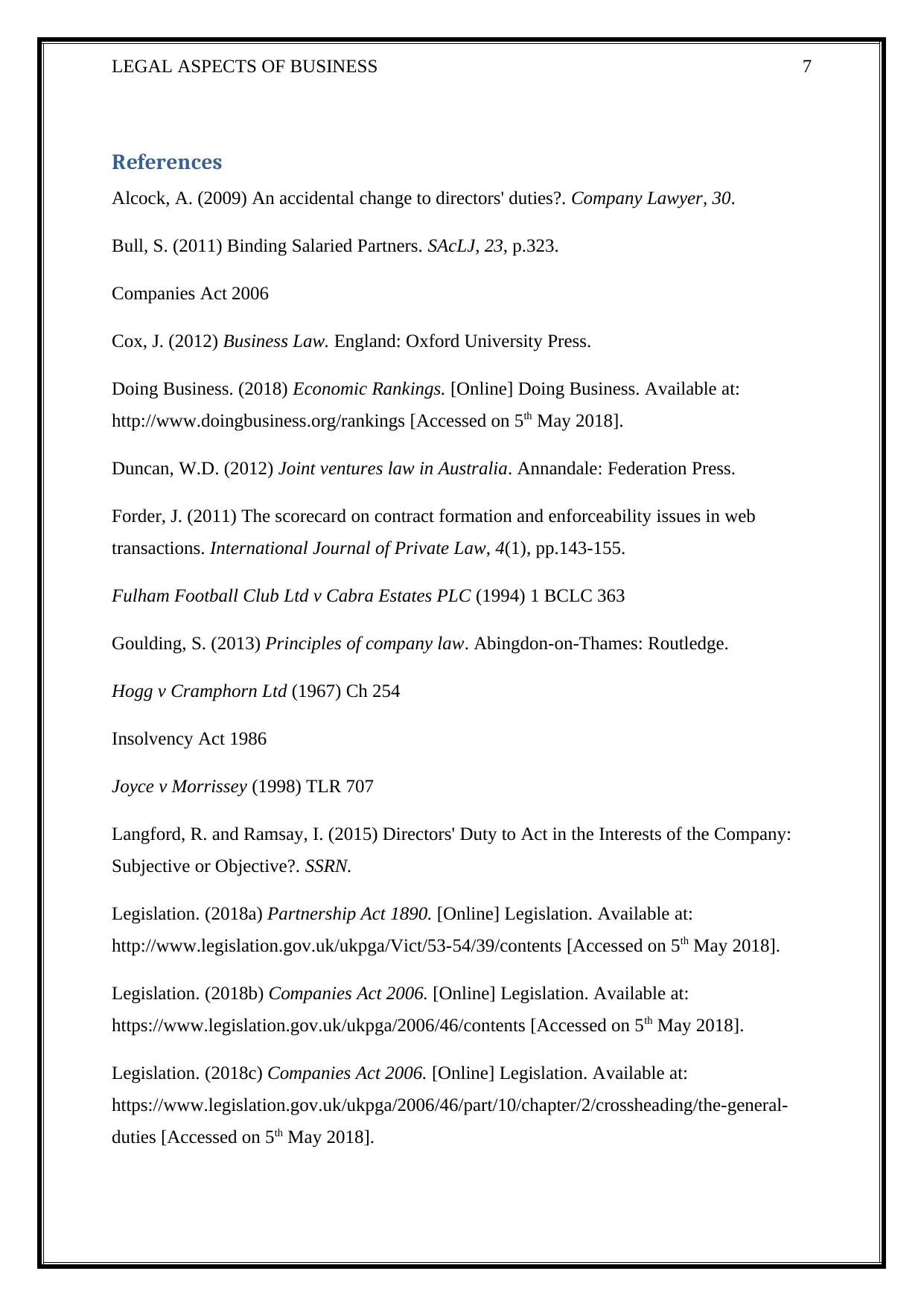
LEGAL ASPECTS OF BUSINESS 7
References
Alcock, A. (2009) An accidental change to directors' duties?. Company Lawyer, 30.
Bull, S. (2011) Binding Salaried Partners. SAcLJ, 23, p.323.
Companies Act 2006
Cox, J. (2012) Business Law. England: Oxford University Press.
Doing Business. (2018) Economic Rankings. [Online] Doing Business. Available at:
http://www.doingbusiness.org/rankings [Accessed on 5th May 2018].
Duncan, W.D. (2012) Joint ventures law in Australia. Annandale: Federation Press.
Forder, J. (2011) The scorecard on contract formation and enforceability issues in web
transactions. International Journal of Private Law, 4(1), pp.143-155.
Fulham Football Club Ltd v Cabra Estates PLC (1994) 1 BCLC 363
Goulding, S. (2013) Principles of company law. Abingdon-on-Thames: Routledge.
Hogg v Cramphorn Ltd (1967) Ch 254
Insolvency Act 1986
Joyce v Morrissey (1998) TLR 707
Langford, R. and Ramsay, I. (2015) Directors' Duty to Act in the Interests of the Company:
Subjective or Objective?. SSRN.
Legislation. (2018a) Partnership Act 1890. [Online] Legislation. Available at:
http://www.legislation.gov.uk/ukpga/Vict/53-54/39/contents [Accessed on 5th May 2018].
Legislation. (2018b) Companies Act 2006. [Online] Legislation. Available at:
https://www.legislation.gov.uk/ukpga/2006/46/contents [Accessed on 5th May 2018].
Legislation. (2018c) Companies Act 2006. [Online] Legislation. Available at:
https://www.legislation.gov.uk/ukpga/2006/46/part/10/chapter/2/crossheading/the-general-
duties [Accessed on 5th May 2018].
References
Alcock, A. (2009) An accidental change to directors' duties?. Company Lawyer, 30.
Bull, S. (2011) Binding Salaried Partners. SAcLJ, 23, p.323.
Companies Act 2006
Cox, J. (2012) Business Law. England: Oxford University Press.
Doing Business. (2018) Economic Rankings. [Online] Doing Business. Available at:
http://www.doingbusiness.org/rankings [Accessed on 5th May 2018].
Duncan, W.D. (2012) Joint ventures law in Australia. Annandale: Federation Press.
Forder, J. (2011) The scorecard on contract formation and enforceability issues in web
transactions. International Journal of Private Law, 4(1), pp.143-155.
Fulham Football Club Ltd v Cabra Estates PLC (1994) 1 BCLC 363
Goulding, S. (2013) Principles of company law. Abingdon-on-Thames: Routledge.
Hogg v Cramphorn Ltd (1967) Ch 254
Insolvency Act 1986
Joyce v Morrissey (1998) TLR 707
Langford, R. and Ramsay, I. (2015) Directors' Duty to Act in the Interests of the Company:
Subjective or Objective?. SSRN.
Legislation. (2018a) Partnership Act 1890. [Online] Legislation. Available at:
http://www.legislation.gov.uk/ukpga/Vict/53-54/39/contents [Accessed on 5th May 2018].
Legislation. (2018b) Companies Act 2006. [Online] Legislation. Available at:
https://www.legislation.gov.uk/ukpga/2006/46/contents [Accessed on 5th May 2018].
Legislation. (2018c) Companies Act 2006. [Online] Legislation. Available at:
https://www.legislation.gov.uk/ukpga/2006/46/part/10/chapter/2/crossheading/the-general-
duties [Accessed on 5th May 2018].
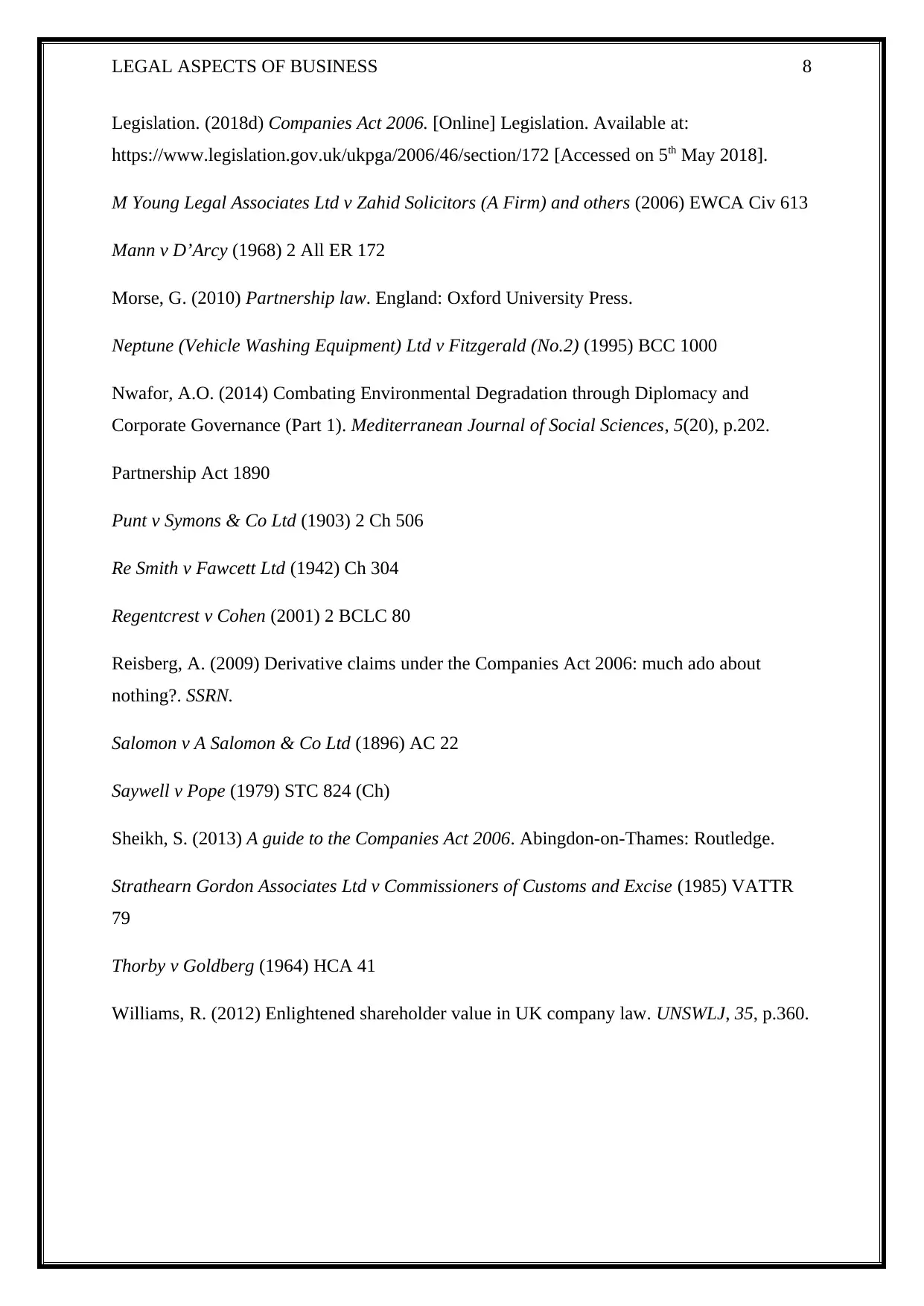
LEGAL ASPECTS OF BUSINESS 8
Legislation. (2018d) Companies Act 2006. [Online] Legislation. Available at:
https://www.legislation.gov.uk/ukpga/2006/46/section/172 [Accessed on 5th May 2018].
M Young Legal Associates Ltd v Zahid Solicitors (A Firm) and others (2006) EWCA Civ 613
Mann v D’Arcy (1968) 2 All ER 172
Morse, G. (2010) Partnership law. England: Oxford University Press.
Neptune (Vehicle Washing Equipment) Ltd v Fitzgerald (No.2) (1995) BCC 1000
Nwafor, A.O. (2014) Combating Environmental Degradation through Diplomacy and
Corporate Governance (Part 1). Mediterranean Journal of Social Sciences, 5(20), p.202.
Partnership Act 1890
Punt v Symons & Co Ltd (1903) 2 Ch 506
Re Smith v Fawcett Ltd (1942) Ch 304
Regentcrest v Cohen (2001) 2 BCLC 80
Reisberg, A. (2009) Derivative claims under the Companies Act 2006: much ado about
nothing?. SSRN.
Salomon v A Salomon & Co Ltd (1896) AC 22
Saywell v Pope (1979) STC 824 (Ch)
Sheikh, S. (2013) A guide to the Companies Act 2006. Abingdon-on-Thames: Routledge.
Strathearn Gordon Associates Ltd v Commissioners of Customs and Excise (1985) VATTR
79
Thorby v Goldberg (1964) HCA 41
Williams, R. (2012) Enlightened shareholder value in UK company law. UNSWLJ, 35, p.360.
Legislation. (2018d) Companies Act 2006. [Online] Legislation. Available at:
https://www.legislation.gov.uk/ukpga/2006/46/section/172 [Accessed on 5th May 2018].
M Young Legal Associates Ltd v Zahid Solicitors (A Firm) and others (2006) EWCA Civ 613
Mann v D’Arcy (1968) 2 All ER 172
Morse, G. (2010) Partnership law. England: Oxford University Press.
Neptune (Vehicle Washing Equipment) Ltd v Fitzgerald (No.2) (1995) BCC 1000
Nwafor, A.O. (2014) Combating Environmental Degradation through Diplomacy and
Corporate Governance (Part 1). Mediterranean Journal of Social Sciences, 5(20), p.202.
Partnership Act 1890
Punt v Symons & Co Ltd (1903) 2 Ch 506
Re Smith v Fawcett Ltd (1942) Ch 304
Regentcrest v Cohen (2001) 2 BCLC 80
Reisberg, A. (2009) Derivative claims under the Companies Act 2006: much ado about
nothing?. SSRN.
Salomon v A Salomon & Co Ltd (1896) AC 22
Saywell v Pope (1979) STC 824 (Ch)
Sheikh, S. (2013) A guide to the Companies Act 2006. Abingdon-on-Thames: Routledge.
Strathearn Gordon Associates Ltd v Commissioners of Customs and Excise (1985) VATTR
79
Thorby v Goldberg (1964) HCA 41
Williams, R. (2012) Enlightened shareholder value in UK company law. UNSWLJ, 35, p.360.
⊘ This is a preview!⊘
Do you want full access?
Subscribe today to unlock all pages.

Trusted by 1+ million students worldwide
1 out of 9
Related Documents
Your All-in-One AI-Powered Toolkit for Academic Success.
+13062052269
info@desklib.com
Available 24*7 on WhatsApp / Email
![[object Object]](/_next/static/media/star-bottom.7253800d.svg)
Unlock your academic potential
Copyright © 2020–2025 A2Z Services. All Rights Reserved. Developed and managed by ZUCOL.





